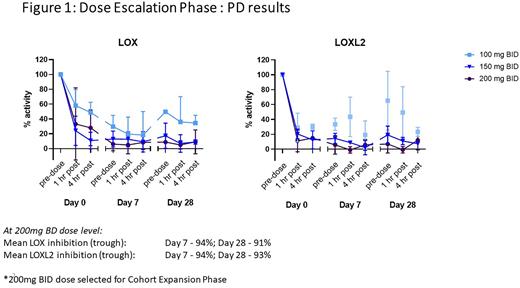Abstract
Background: Janus kinase (JAK) inhibitors for myelofibrosis (MF) treatment have provided major clinical benefits, but do not improve cytopenias and demonstrate only modest effects on bone marrow fibrosis (BMF). High discontinuation rates are observed due to loss of therapeutic effect or drug induced toxicity. Reducing BMF may normalize the hematopoietic environment and improve symptoms of MF, particularly blood cell counts. Limited therapeutic options highlight the need for novel, effective therapies for primary MF (PMF).
Lysyl oxidases (LOX) are a family of enzymes responsible for the critical post-translational modification essential for the biogenesis of cross-linked collagen and elastin, which form the basis of reticulin in bone marrow (BM). Importantly, several members of the lysyl oxidase family are upregulated in MF providing a rationale to therapeutically inhibit all lysyl oxidases. PXS-5505 is a pan-lysyl oxidase inhibitor that prevents the cross-linking of collagen and elastin and consequently exhibits anti-fibrotic effects in murine models of MF.
PXS5505-MF-101 is an ongoing, multi-center, open-label phase 1/2a study evaluating the safety and tolerability of PXS-5505 in patients with primary, post-polycythemia vera (PV) or post-essential thrombocythemia (ET) myelofibrosis (NCT04676529). Herein, we present the study design and preliminary data from the dose escalation phase of this study.
Methods: The primary objective is to determine the safety and tolerability of PXS-5505In patients with MF. Secondary objectives include determination of appropriate dose, pharmacokinetics (PK) and pharmacodynamics (PD), changes in BMF using European Consensus, spleen volume and MF symptoms (MFSAF). Efficacy endpoints are exploratory.
Eligible patients must have PMF or post-ET/PV MF of intermediate/high risk, relapsed/refractory, intolerant or not eligible to available JAK inhibitors (ruxolitinib, febratinib), including those with severe thrombocytopenia, and requiring therapy for symptomatic disease.
Patients participating in the DEP required BM biopsy within 6 months of the re-initiation of treatment with PXS-5505. For patients entering the CEP a BM biopsy must have been performed within 3 months prior to Day 1 treatment.
The study consists of two phases: Dose Escalation Phase (DEP) and Cohort Expansion Phase (CEP).
The DEP followed a 3+3 design with a starting dose of 100 mg PXS-5505 twice daily (BID) for 4 weeks (Level 1), escalating to 150 mg BID (Level 2) and to 200 mg BID (Level 3). The DEP was to determine the maximum tolerated dose (MTD) or if all doses were well tolerated, the dose which provided the highest target engagement PK and PD measures during dose escalation (Day 0, week 1 and week 4) included, maximum plasma concentration (C1hr=Cmax), minimum plasma concentration (Cmin) and LOX and LOXL2 inhibition in plasma which would subsequently be the dose selected for the CEP. Intra patient dose escalation was allowed and patients participating in the DEP phase were able to continue on the CEP up to 6 months of therapy.
During the CEP, 24 patients will be treated at the dose determined from the DEP phase. At data cutoff (21 July 2022) the DEP was completed and enrollment for the CEP continues.
Results: Five patients were enrolled in the DEP. This included three patients with post ET MF, one patient with post PV MF and one patient with post ET MF. The median age was 71 years (range, 60-77) and all were female. There were no suspected unexpected serious adverse reactions (SUSAR) or dose limiting toxicities during the dose escalation phase. One patient terminated early following transformation to AML (24 days post treatment initiation). Interim PK data from the DEP phase demonstrated that PK properties in patients were similar to PK in healthy volunteers as previously reported at all dose levels (ACTRN12619000332123). At the 200mg BID level the mean (trough) LOX inhibition was 94% and 91% (days 7 and 28), respectively (Figure 1). Similarly, the mean (trough) LOXL2 inhibition was 94% and 93% (days 7 and 28), respectively.
Enrolment in the CEP continues and preliminary data will be presented.
Conclusion: These findings indicate that excellent targeted LOX and LOXL2 inhibition is being achieved at the 200mg BID level which has been selected as the recommended dose for the currently ongoing expansion phase with no dose limiting toxicity seen.
Disclosures
Baker:Biegene: Research Funding; Pharmaxis: Research Funding; Roche: Membership on an entity's Board of Directors or advisory committees; Janssen-Cilag: Membership on an entity's Board of Directors or advisory committees; Bayer: Research Funding; Takeda: Research Funding; Pfizer: Research Funding; Daiichi Sankyo: Research Funding; CSL Behring: Research Funding; Roche: Research Funding; Amgen: Research Funding; Celgene: Research Funding; Rigel Pharmaceuticals: Research Funding; Abbvie: Research Funding; Sanofi: Research Funding; MorphSys AG: Research Funding; Acerta Pharma: Research Funding; Jansen-Cilag: Research Funding; Bristol-Myers Squibb: Research Funding; Boehringer Ingelheim: Research Funding; Portola: Research Funding; Technoclone: Research Funding; Alexion: Research Funding; Bayer: Honoraria; Cardinal Health: Honoraria; Bristol-Myers Squibb: Honoraria; Jansen-Cilag: Honoraria; Roche: Honoraria; Pharmaxis: Other: Data Safety Monitoring Board or Advisory Board ; Jansen-Cilag: Other: Data Safety Monitoring Board or Advisory Board ; Roche: Other: Data Safety Monitoring Board or Advisory Board . Baskar:Pharmaxis Ltd: Current Employment. Charlton:Pharmaxis Ltd: Current Employment, Current equity holder in publicly-traded company. Hobbs:Incyte: Other: Advisor or review panel participant; PI, Research Funding; Abbvie Pharmaceuticals: Membership on an entity's Board of Directors or advisory committees, Other: Advisor or review panel participant; Constellation: Membership on an entity's Board of Directors or advisory committees, Other: Advisor or review panel participant; PI, Research Funding; Pfizer: Other: Advisor or review panel participant; Novartis: Membership on an entity's Board of Directors or advisory committees, Other: Advisor or review panel participant; Pharmaxis: Other: Advisor or review panel participant; Keros: Other: Advisor or review panel participant; Bristol Myers Squibb Co./Celgene: Membership on an entity's Board of Directors or advisory committees, Other: Advisor or review panel participant; Bayer: Research Funding; Merck: Research Funding. Jarolimek:Pharmaxis Ltd: Current Employment, Current equity holder in publicly-traded company.
Author notes
Asterisk with author names denotes non-ASH members.


This feature is available to Subscribers Only
Sign In or Create an Account Close Modal